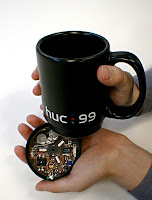On Friday afternoon I had the privilege to present the closing keynote at AMI2011 in Amsterdam with the title ‘Beyond Ubicomp – Computing is Changing the Way we Live’. The conference featured research in Ambient Intelligence ranging from networking and system architecture to interfaces and ethnography. It brought an interesting set of people together and it was good to see many students and young researchers presenting their work.
In my closing keynote at talked about my experience of the last 13 years in this field and about a vision of the future. My vision is based on a basic technology assessment – basically looking what technologies will (in my view) definitely come over the next 20 years and looking at the implications of this. I stared out with a short reference to Mark Weiser’s now 20 year old article [1]. The upcoming issue of IEEE Pervasive Magazine will have a in-depth analysis of the last 20 years since Weiser’ article – we have also an article in there on how interaction evolved.
The vision part of the talk looked “Perception beyond there here and now” [2] from 3 different angles:
- Paradigm Shift in Communication
Here I argue that the default communication in the future will be public communication and only if something is secret we will try to use non public channel. First indicators of this are a switch from email to twitter and facebook. I used a cake baking example to highlight the positive points of this shift. - Steep Increase in media capture
The second angle is just observing and extrapolating the increase in capture of media information. If you go already now on youtube you will information about many things (backing a cake, repairing a bike, etc.). The implication of this increase in media capture will be virtually unlimited access to experience other people share - Transformation of experienced perception
The final angle is that this creates a new way of perceiving the world. We will extent perception beyond the here and now and this is bringing a completely new way of creating and accessing information. I used the example of enquiring about buying an international train ticket at the station in Amsterdam. If you can look there through other people’s eyes the question becomes trivial.
My overall argument is that we are in for a major transformation of our knowledge and information culture. I would expect that this shift is as radical as the shift from an oral tradition to the written societies – but the transition will be much quicker and in the context of a globalized and competitive world.
The main conclusion from this is: Ethics and values are the central design material of this century.
Looking at twitter it seems it got across to some in the audience 😉 If your are interested, too have a look at the slides from the keynote.
[1] Mark Weiser. The computer for the 21st century. Scientific American, Vol. 265, No. 3. (1991)
[2] Albrecht Schmidt, Marc Langheinrich, and Kritian Kersting. 2011. Perception beyond the Here and Now. Computer 44, 2 (February 2011), 86-88. DOI=10.1109/MC.2011.54 http://dx.doi.org/10.1109/MC.2011.54








 Christofer Lueg
Christofer Lueg

